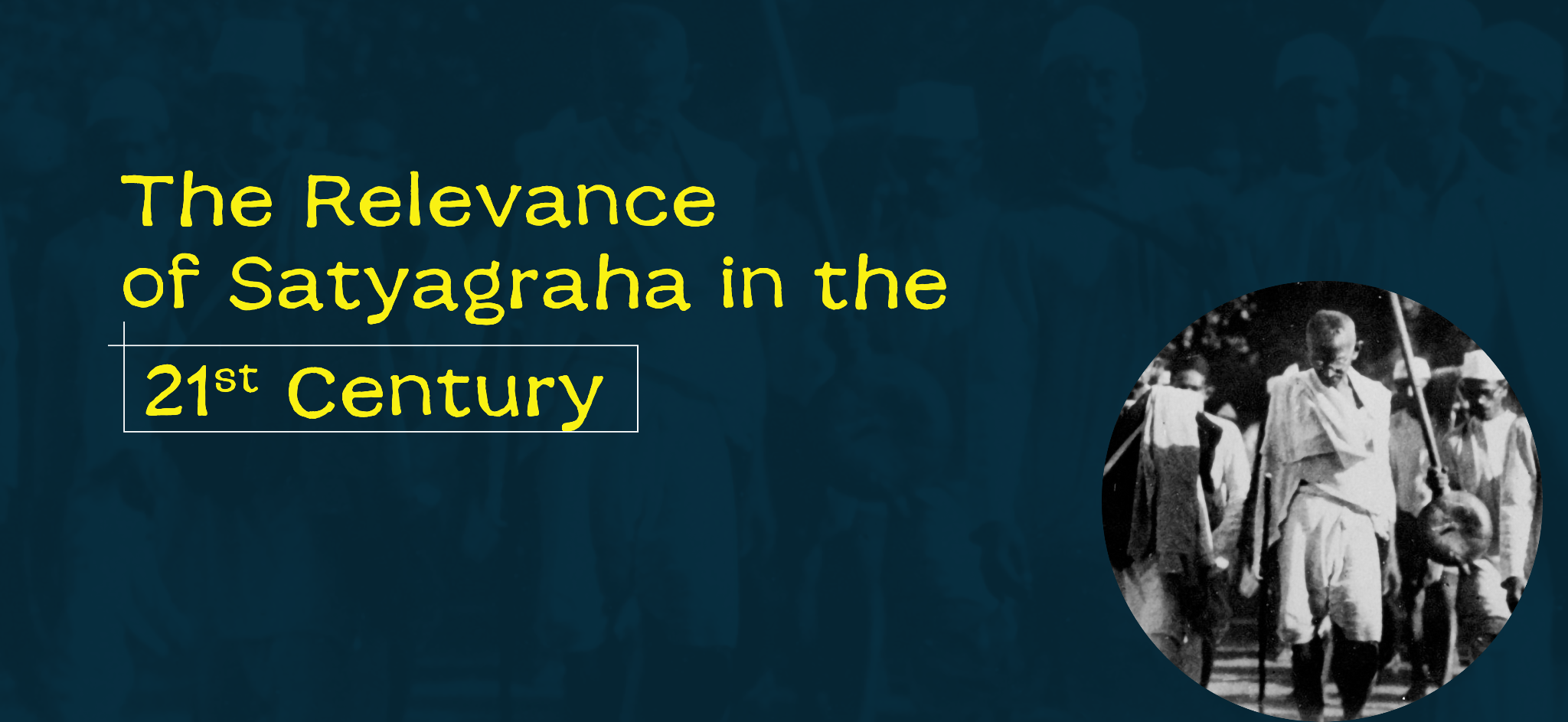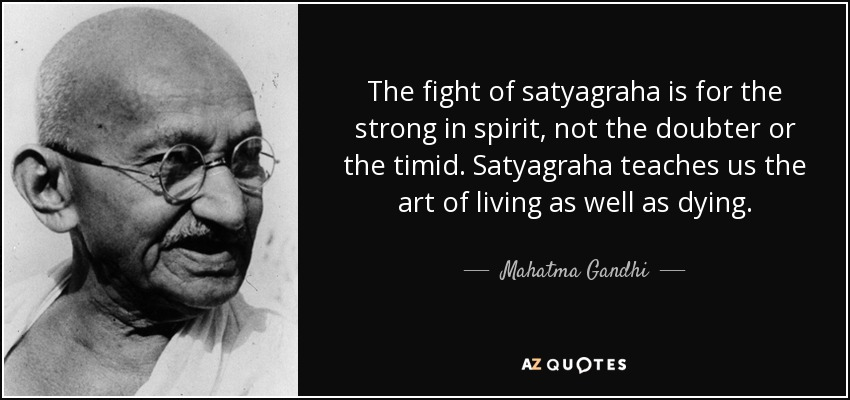The Relevance of Satyagraha in the 21st Century
Blogs Home
- 03 Oct 2024

In 2011, the streets of India buzzed with peaceful protests led by an elderly man dressed in simple white khadi, sitting cross-legged in meditation. His name was Anna Hazare, and his hunger strike against rampant government corruption drew millions of supporters from across the country. Inspired by the legacy of Mahatma Gandhi, Hazare’s non-violent protest, known as the India Against Corruption movement, pressured the Indian government to enact stronger anti-corruption laws.
This moment mirrors the essence of Mahatma Gandhi’s philosophy of Satyagraha, a forceful yet peaceful resistance that calls upon the power of truth and non-violence. As we reflect on Gandhi’s legacy on his 155th birth anniversary, we are reminded that his timeless principles remain a potent force for change in the 21st century.
Understanding Satyagraha
Satyagraha is a word made up of two parts: "Satya" and "Agraha"
"Satya" comes from the word "sat," which means being real, true, right, or existing as things really are. It doesn't just mean telling the truth but also refers to things that are pure, good, and effective.
"Agraha" comes from the word "grah," meaning to seize, grasp, or hold onto. So, Satyagraha means "holding firmly to the truth" or "standing strong for the truth" with a commitment to finding and reaching that truth.
Gandhi explained that Satyagraha means “holding on to the truth,” which he called “truth-force” or “soul-force”.To hold on to the truth, it is essential to first discover the truth.
Thus, Satyagraha is an active technique of action in a conflict situation which consists of a search for the truth and a struggle for its vindication through various techniques.
Techniques of Satyagraha
The methods of Satyagraha can be broadly classified into four main categories:
- Purificatory and Penitential Practices: These involve personal commitment through pledges, prayers, and fasts aimed at self-purification and moral reflection. They help individuals strengthen their resolve to fight against injustice.
- Non-Cooperation: It is a refusal to participate in unjust systems, including strikes, boycotts, and fasting. It is a form of peaceful resistance to challenge and weaken the authority of oppressors.
- Civil Disobedience: This involves the deliberate and peaceful violation of unjust laws through picketing, marches, and tax refusal. This aims to demonstrate the moral wrongness of certain laws without resorting to violence.
- Constructive Programme: It involves engaging in social reform and community work, including promoting unity, removing untouchability, adult education, village improvement, and developing nonviolent labor unions. It aims to build a just society through grassroots efforts.
Gandhi’s Journey with Satyagraha
Gandhi applied Satyagraha—his philosophy of nonviolent resistance—throughout his life to address various social, political, and economic injustices.
In South Africa, he led a civil disobedience campaign against discriminatory laws, emphasizing truth-force and self-suffering.
The Champaran Satyagraha of 1917 showcased his commitment to justice for oppressed indigo farmers, while the Kheda campaign in 1918 highlighted the power of nonviolent resistance during a famine. The iconic Salt March in 1930 symbolized the fight against British exploitation, and the Quit India Movement in 1942 demanded an end to colonial rule.
Even during communal tensions post-independence, Gandhi fasted for peace, demonstrating that Satyagraha was not merely a political tool but a holistic way of life rooted in truth, nonviolence, and moral integrity.
Satyagraha Beyond Gandhi
After Gandhi, the principles of Satyagraha continued to inspire global movements for change. In the 1960s, Martin Luther King Jr. used nonviolent protests in the American Civil Rights Movement to combat racial segregation and injustice.
Similarly, Nelson Mandela applied these ideas in his fight against apartheid in South Africa, advocating for patience and truth.
In India, movements like Sarvodaya and Bhoodan emerged in the 1950s, while Jayaprakash Narayan's "Total Revolution" campaign in the 1970s addressed corruption. Other significant movements included the Chipko Andolan against deforestation and the Narmada Bachao Andolan, led by Medha Patkar, who protested against dam construction.
Relevance of Satyagraha Today
- Satyagraha as a Means of Conflict Resolution:
- Satyagraha continues to be a powerful tool for conflict resolution in current times, with its emphasis on truth, non-violence, and dialogue.
- The Farmers’ Protest against three controversial agricultural laws passed by the Indian government in 2020 was widely seen as a revival of Gandhian methods of peaceful resistance.
- Satyagraha as a Means of Social Justice:
- Social movements around the world continue to draw from Satyagraha in their quest for justice.
- The Black Lives Matter (BLM) movement, which surged in response to the killings of unarmed Black people by police, exemplifies the spirit of Satyagraha in its use of peaceful protest to confront systemic racism and police brutality.
- Satyagraha as a Tool of Climate Activism:
- As the world grapples with the climate crisis, Gandhi’s vision of simple living, environmental stewardship, and non-violence can inspire today’s climate activism.
- The Fridays for Future movement, started by Swedish climate activist Greta Thunberg, has become a global example of non-violent resistance in the fight against climate change.
- Addressing Economic Inequality:
- Gandhi saw economic inequality as a form of violence that needed to be resisted through Satyagraha. He believed that concentration of wealth in the hands of a few while millions lived in poverty was morally wrong and unjust.
- The principle of Trusteeship is central to Gandhi’s vision for achieving economic equality in a non-violent manner. According to Gandhi, the wealthy should not be seen as the owners of their wealth but as trustees who hold their wealth on behalf of society.
- The Tata Group, one of India’s largest and most respected business conglomerates, has long incorporated the idea of trusteeship in its business philosophy.
- In the modern context, trusteeship aligns with the idea of corporate social responsibility (CSR), where businesses are expected to contribute to the social and environmental welfare of the communities they operate in.
- Satyagraha and Women’s Rights:
- Contemporary women movements worldwide continue to employ non-violent methods rooted in Satyagraha to challenge patriarchy and advocate for women’s rights
- The mass protests after the Nirbhaya incident, rooted in Satyagraha principles, led to the passage of the Criminal Law (Amendment) Act in 2013, which established stricter punishments for rapists, expedited trials, and recognized various forms of sexual assault.
- Empowering Villages Through Panchayati Raj Institutions:
- Panchayati Raj Institutions (PRIs), rooted in Gandhi’s vision of Gram Swaraj (village self-governance), play a vital role in empowering villages through decentralized democracy, local decision-making, and sustainable development.
- The accountability mechanisms within PRIs, such as Gram Sabhas, resonate with Satyagraha’s emphasis on truth and moral integrity.
- Empowerment of Indigenous Communities:
- Satyagraha principles empower Indigenous communities to assert their rights over forest land that they have traditionally inhabited and managed
- Activists like Dayamani Barla have led peaceful protests, sit-ins, and legal battles to secure the implementation of the Forest Rights Act, 2006, which grants tribal communities the legal right to their ancestral land.
- Digital Satyagraha:
- It refers to the use of digital platforms and technologies to promote truth and counter misinformation, embodying the principles of Satyagraha in the contemporary digital landscape.
- Fact-checking units play a vital role in this movement, actively engaging in non-violent resistance against manipulation and propaganda through the dissemination of verified information.
- The #MeToo movement, which began in 2017, utilized social media as a platform for non-violent resistance against sexual harassment and assault, empowering women to share their stories and demand justice.
Challenges and Criticism
Satyagraha is a powerful method for enacting social change, yet it encounters significant challenges in today's world, especially in nations with authoritarian regimes that respond violently to dissent. The effectiveness of non-violent resistance can be called into question under such circumstances.
For instance, Aung San Suu Kyi has been a prominent symbol of peaceful protest against Myanmar's military junta, leading demonstrations since 1988. Although she was awarded the Nobel Peace Prize in 1991, the impact of her Satyagraha efforts remains limited, as the military regime continues to maintain power with little regard for democratic principles.
Similarly, Dalai Lama has consistently advocated for Tibetan freedom through nonviolent resistance against Chinese occupation. His efforts to promote peace and dialogue have not yet yielded the desired results.
Additionally, critics point out that in an age dominated by instant communication and digital activism, the slow and deliberate nature of Satyagraha may struggle to attract the necessary support and momentum.
Conclusion
While some Satyagraha campaigns may not have achieved their desired outcomes, this does not render the concept irrelevant in today's context. The challenges faced do not arise from the principles of Satyagraha itself but rather from the practitioners navigating an imperfect world.
Although achieving perfect non-violence is unattainable—since life inherently involves some degree of violence—Satyagraha provides a framework for reducing harm through nonviolent struggle.
Mahatma Gandhi articulated the philosophy of Satyagraha, stating, "The world rests upon the bedrock of satya or Truth. Asatya, or untruth, signifies non-existence; thus, the victory of untruth is out of the question. Truth, being 'that which can never be destroyed,' has been consistently emphasized in Indian scriptures."
This sentiment is echoed in the ancient verse:
सत्यमेव जयते नानृतं
सत्येन पन्ता विततो देवयानः।
योनाक्रमन्त्य ऋषयो ह्याप्तकामा
यत्र तत् सत्यस्य परमं निधानम्।।
Translated, this means: "Truth alone triumphs, not falsehood. Through truth, the divine path is laid out by which the sages, whose desires have been completely fulfilled, reach the source of ultimate truth.”
The 21st century offers us the opportunity to embrace the wisdom of Satyagraha, not only as a means of addressing specific injustices but as a way of living. Whether in the fight against climate change, social inequality, or global conflicts, Gandhi’s message of truth, non-violence, and moral courage continues to be a beacon of hope and a guide toward a more just and compassionate world.
References :
- https://www.mkgandhi.org/articles/relevance2.php
- https://www.mkgandhi.org/articles/relevance-of-Satyagraha-as-a-weapon-of-conflict-resolution.php#:~:text=Gandhi's%20satyagraha%20proved%20to%20be,adoption%20of%20the%20Gandhian%20Way.
- https://www.gandhiashramsevagram.org/gandhi-articles/Relevance-of-Gandhi-in-modern-times.php
- https://egyankosh.ac.in/bitstream/123456789/33830/1/Unit-14.pdf
- https://www.livemint.com/Politics/AeKzn7TXUJNXKSoLF6wpVN/How-Satyagraha-still-drives-change-globally.html
- https://www.gandhiashramsevagram.org/gandhi-articles/Relevance-of-Gandhi-in-modern-times.php






